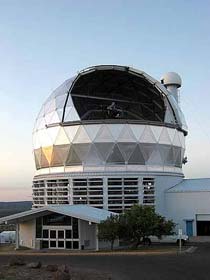
Handy Links
SLAC News Center
SLAC Today
- Subscribe
- Archives: Feb 2006-May 20, 2011
- Archives: May 23, 2011 and later
- Submit Feedback or Story Ideas
- About SLAC Today
SLAC News
Lab News
- Interactions
- Lightsources.org
- ILC NewsLine
- Int'l Science Grid This Week
- Fermilab Today
- Berkeley Lab News
- @brookhaven TODAY
- DOE Pulse
- CERN Courier
- DESY inForm
- US / LHC
SLAC Links
- Emergency
- Safety
- Policy Repository
- Site Entry Form

- Site Maps
- M & O Review
- Computing Status & Calendar
- SLAC Colloquium
- SLACspeak
- SLACspace
- SLAC Logo
- Café Menu
- Flea Market
- Web E-mail
- Marguerite Shuttle
- Discount Commuter Passes
-
Award Reporting Form
- SPIRES
- SciDoc
- Activity Groups
- Library
Stanford
Around the Bay
GLAST's Dance Card Begins to Fill
 The Gamma-ray Large Area Space Telescope (GLAST) is scheduled for launch early next year, and although it will observe a great variety of interesting high-energy sources, one type of object in particular is expected to dominate the gamma-ray sky: a special class of active galactic nuclei known as "blazars." GLAST will detect thousands of blazars, and in anticipation of this volume of new data,
astronomers at the Kavli Institute for Particle Astrophysics and Cosmology (KIPAC),
located at the Stanford Linear Accelerator Center (SLAC), in collaboration with their colleagues at Caltech, at Oxford, and in Europe, have assembled the Candidate Gamma-Ray Blazar Survey, or CGRaBS.
The Gamma-ray Large Area Space Telescope (GLAST) is scheduled for launch early next year, and although it will observe a great variety of interesting high-energy sources, one type of object in particular is expected to dominate the gamma-ray sky: a special class of active galactic nuclei known as "blazars." GLAST will detect thousands of blazars, and in anticipation of this volume of new data,
astronomers at the Kavli Institute for Particle Astrophysics and Cosmology (KIPAC),
located at the Stanford Linear Accelerator Center (SLAC), in collaboration with their colleagues at Caltech, at Oxford, and in Europe, have assembled the Candidate Gamma-Ray Blazar Survey, or CGRaBS.
The goal of the CGRaBS project is to select, in advance of the launch of GLAST, the best and brightest sources that GLAST will see. CGRaBS has identified the 1,625 objects that have radio and X-ray properties that are the most "blazar-like." The CGRaBS team attempts to gather optical data on each source to determine its precise classification and its redshift, which is a measure of its distance from us. Most of the CGRaBS optical campaign has been conducted on the Hobby-Eberly Telescope at McDonald Observatory in west Texas. Additional observations have been conducted at other large telescopes throughout the world, including at Palomar Observatory in southern California, at the Very Large Telescope in Chile, and at the 10-meter Keck telescope at the summit of Mauna Kea.
By learning about as many objects as possible before GLAST launches, the CGRaBS team can pick out the most interesting or unusual sources in advance, allowing them to identify which sources will warrant more careful study in the GLAST era. In essence, by "doing their homework" on these objects before GLAST detects them, the team can avoid constantly having to "play catch-up" after GLAST detects them. With the CGRaBS list as a guide, and the unprecedented quality of the gamma-ray data from GLAST, the coming years will be a very exciting time for blazar science.
—Steve Healey, SLAC Today, October 4, 2007
Above image: The Hobby-Eberly Telescope at McDonald Observatory in west Texas. (Photo credit McDonald Observatory. Click image for larger version.)